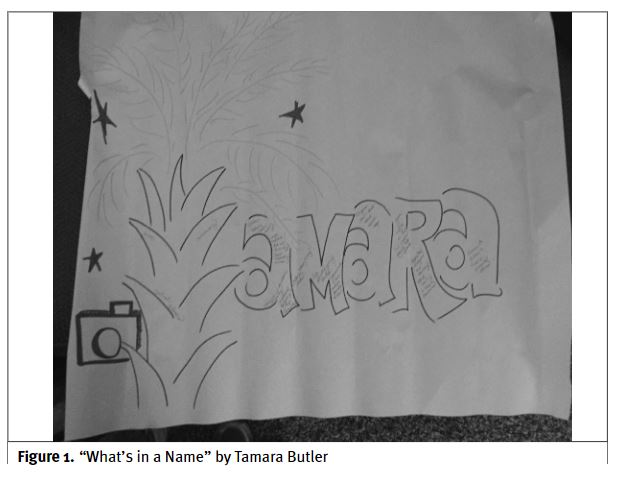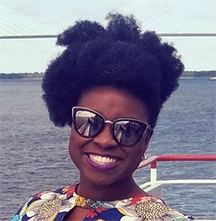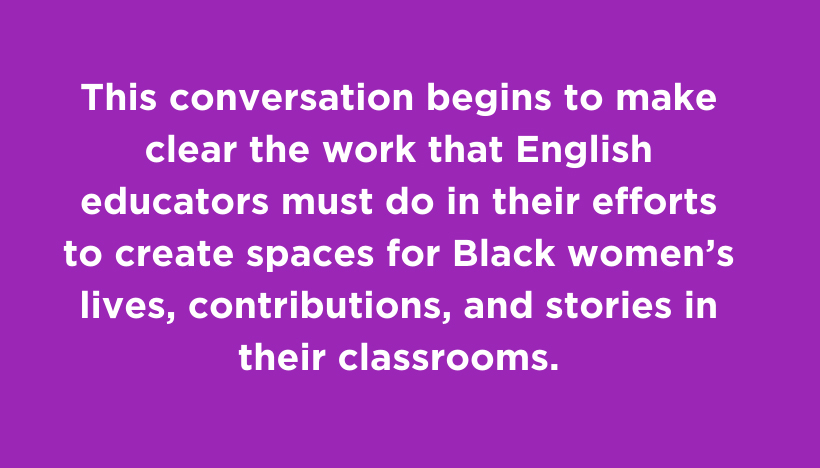This is an excerpt from “#Say[ing]HerName as Critical Demand: English Education in the Age of Erasure,” by Tamara T. Butler, which appeared in the January 2017 issue of English Education.
In this article Tamara T. Butler advocates “for educators and scholars to teach about the lives of Black women using Black women’s autobiographies” and “position[s] #SayHerName as a critical Black and decolonial feminist demand through which students can (a) begin to learn about the historical and contemporary contributions of Black women, (b) recognize the intricate links between Black women’s lived experiences and political activism, and (c) see their lives as grounds for political and social change.”
In the following excerpt from the final section, Butler offers vignettes that focus on a one-week summer program for high school students.
To pedagogically “#SayHerName” means to intentionally teach the autobiographical texts of Black women in English education and K–12 language arts classrooms. More specifically, #Say[ing]HerName means that educators commit to exploring how Black women writers teach strategies to say, and the importance of saying, Black women’s names. In this section, I offer four vignettes [*three are included here] where I used Black women’s lives and stories as inquiry artifacts, which I define as texts (digital, written, or visual) that serve as catalysts for research, dialogue, and/or social change.
“Uncovering Invisible Activists”: Scenes from a Summer Enrichment Program
The following three vignettes are derived from “I Am Everyday People: Uncovering Invisible Activists for Change and Action,” a one-week summer residential program I designed for rising ninth-and tenth-grade students. The title borrows from Sartain’s (2007) Invisible Activists, which highlights the lives and leadership of Black women in Louisiana branches of the National Association for the Advancement for Colored People (NAACP). Each student received a course packet filled with various nonfiction readings about and by Black women activists, including articles from scholarly journals and chapters from women’s autobiographies.
Over the course of the week, the students had to complete a multimodal project based on the life of a Black woman activist whom they selected within the first two days of the program. In the following vignettes, I recount three components of the final multimodal project in which students (1) researched their own life stories, (2) explored our collective understanding of activism, and (3) used the names of Black women activists as inquiry artifacts.
As the program developer and facilitator, I represent the vignettes based on my mental notes and written notes and some of the students’ written reflections that emerged from the week.
Scene 1: What’s in a Name?
Before the students began any of their research projects, they started with “What’s in a name” mini-projects. To begin this project, the students and I sat in a circle with our yellow legal notepads. We were to silently record our own answers to the following questions:
- What does your name mean? Who named you, or what is the story behind your name?
- What do you want your legacy to be?
- What is your greatest accomplishment?
- Where are you from?
- Why are you here? What do you hope to learn?
- What do you bring to this class?
I did not ask the students to share what they had written. Instead, I provided the students with large sheets of white paper, markers, crayons, construction paper, and glue. The students were tasked to create an artistic representation of their name, with their answers to the proceeding questions inside of the name (see Figure 1 for my image).

I was immediately met with “I’m not an artist,” “I don’t know how to draw,” and similar declarations. After students gathered their supplies and realized that they were required to complete the task regardless of their artistic skills, they settled into their own spaces throughout the room. Some students asked others to draw their name in large bubble letters. They later traced the penciled letters with markers and wrote their answers inside of the letters.
As I circled the room to check on the students’ progress, one female student shared that her name “didn’t have a meaning.” Another student said something similar, in that she did not know the meaning of her name. “Are you sure?” I questioned, giving each girl a quizzical look. I encouraged them to walk to the center’s computer lab and search for their names. About 5 minutes later, the two girls returned. One ran up to me with her name and the definition written in pen on a sheet of paper. “Ms. B! Guess what? My name means ‘beautiful flower’ in Swahili.”
I smiled. “See? That’s beautiful.” I approached the other young girl who had returned to her poster and was coloring her letters. “Well, what did you find?”
“My name means ‘light.’” She confessed that because her name was a combination of her parents’ first names, she thought her name was “made up” and did not have a meaning.
I created the “What’s in a name” mini-project to engage students in a reflective and attentive space, where they would begin with self (Camangian, 2010; Womack, 2013; Woodson, 2014) and start to understand the power of names and naming (Smith, 1999). I asked students to write responses to the questions inside of the letters of their names, so that they can visualize that idea that each name comes with its own stories, desires, aspirations, and truths.
This concept of reading one’s name and the story that is embedded within it connects to reading the word and the world (Freire, 1970/1995). The project focused specifically on critical reflection, where the students were encouraged to think about themselves in order to think about others (Reed & Butler, 2015). It was my hope that the students would carry that same level of excitement, respect, and curiosity into the next element of the project: learning about Black female activists.
Scene 2: What Makes Her an Activist?
“Who are some people that you think of as activists?” I asked as I stood before 12 high school students at the dry-erase board. No response. I posed a different question to the group: “What is an activist?”
“Someone who stands up for what they believe in.”
“OK, are we going with that definition?”
A student added, “Someone who fights for what they believe in.”
With this evolving definition, students began to call out names: “Martin Luther King.” “Rosa Parks.”
I wrote the names on the board. “Who else?”
“Malcolm X.”
“Gandhi.”
“Adolf Hitler.” When met with laughter, groans, and other sounds of disapproval, I asked the student to elaborate. He shared that Hitler stood up for what he believed in. More sounds of disapproval. After a 10-minute debate about whether or not what he believed in was productive to a social justice agenda, the students decided that he did not belong on the list. We continued our discussion as students offered the following names: Abraham Lincoln. Jesus. Mother Teresa. The lady who freed the slaves.
When I asked them to name more women, I was initially met with heavy silence.
Coretta Scott King was mentioned after someone hesitantly said Sojourner Truth.
I stopped writing on the board to pose a follow-up question. “Aside from being married to Martin Luther King, what did Coretta Scott King do to make her an activist?”
This conversation begins to make clear the work that English educators must do in their efforts to create spaces for Black women’s lives, contributions, and stories in their classrooms. Levinson (2008) notes that young people’s knowledge of activists is limited to names, and activism is limited to large social movements. Although students may know the characteristics of individuals they categorize as activists or the movements with which they are associated, students fail to see connections between the work of “extraordinary historical role models” and their own lives. It is important that young people come to understand what activists did as such knowledge informs how students come to develop their own civically engaged identities.
Without seeing their own everyday actions as acts that effect change in their communities, young people are less likely to be politically and civically engaged (Levinson, 2008). To young people, activist/civically engaged identities seem only available to “extraordinary people” or to themselves once they become adults. Through this conversation, we uncovered the gaps in our collective knowledge about Black women’s activism and became acutely aware of why activism was often reserved for men (i.e., Martin Luther King, Malcolm X, Abraham Lincoln) or older women whom we did not know much about (i.e., Rosa Parks, Coretta Scott King, Harriet Tubman, Mother Teresa, Sojourner Truth). Students carried their curiosity about why they had neither learned about these women nor read their auto/biographies and memoirs into the development of their multimodal projects.
Scene 3: Engaging Black Women’s Stories
After we compiled our list of activists, I gave each student a half sheet of paper with the following instructions:
Background: The following is a list of women we may or may not recognize as their stories are either untold or stand in the shadows of individuals such as Dr. Martin Luther King Jr., Malcolm X, A. Philip Randolph, and others. This list contains women who are the presidents of major organizations, are on the FBI’s “Most Wanted” list, created schools, integrated schools, organized boycotts, or changed the face of history.
June Jordan
Carlotta Walls
Assata Shakur
Melba Patillo (Beals)
Claudette Colvin
Septima Poinsette Clark
Elizabeth Eckford
Dorothy Height
Fannie Lou Hamer
Afeni Shakur
Minnijean Brown (Trickey)
Mamie Bradley
Bernice Johnson (Reagon)
Thelma Mothershed-Weir
Gloria Ray (Karlmark)
Your mission: Select one of the women from the list above and research her life. Be prepared to share three intriguing facts about her. Intriguing means to “arouse the curiosity or interest of; fascinate.” Translation: do not simply tell us when and where she was born—tell us something that will leave us wanting to know more about what she did, and who she is (or was).
Once the students read over the list, they each chose one woman.
“That’s Tupac’s mama. I want to research her,” a young man shouted with his hand raised. The students huddled together, curiously looking at their lists, talking, and pointing. “Wait. Which one is Tupac’s mama?”
The young man answered, “Assata.”
“Then she must be Tupac’s auntie,” another student said while pointing to “Afeni Shakur” on the list.
I didn’t answer their questions or dispute their claims. Instead, I offered five dry-erase markers to the group and advised them to write their names on the board next to the activist they wanted to research. Before we ventured to the computer lab, each student understood that they could not switch names and were responsible for finding as many intriguing facts as they could. During the four-hour lab time, students had to locate, decipher, and compile information about the woman they selected. On the following day, they were given another four hours to create Prezi presentations about their Black female activist.
Before students could create their Prezis, they had to create a Word document containing the images and information they wanted to feature in their presentation as well as the corresponding citations. Through 15-minute one-on-one conferences, I asked each student to explain to me why she or he selected the photos and facts. It was an opportunity for them to articulate their decision-making and design process. The computer lab transformed into a buzzing workshop as students helped one another save images, edit grammatical and spelling errors, and generate bibliography/work cited pages. By the end of the week, students presented their learning through the meshing of audio, visuals, and written texts via the Prezi platform. Some students included the audio recording of themselves reading the found poem they created using words from the course texts I provided: Belinda Robnett’s (1997) How Long? How Long? African-American Women in the Struggle for Civil Rights, Carole Weatherford’s (2002) Remember the Bridge, and the introduction to Bernice Barnett’s (1993) “Invisible Southern Black Women Leaders in the Civil Rights Movement.”
While some students focused on what they learned about themselves, others drew connections across space and time. For example, the young lady who researched Mamie Bradley, the mother of Emmitt Till, connected Bradley’s actions to those of Sybrina Fulton, the mother of Trayvon Martin. She discussed how each woman used her son’s death to bring attention to racial injustice and violence.
Students’ final Prezis not only included information about the selected Black female activist but also something they learned about the local community and themselves. In addition to researching a historical activist, students thought about local activism as they engaged in artistic classroom activities, conversed with community elders, participated in a walking neighborhood tour, and visited the local art museum. Some students shared that some of the buildings in the neighborhood were named after Black women (the wives of the builders); others talked about the location of former Black-owned businesses, including a bowling alley, hospital, and floral shop.
Since the summer program, the projects have taken on various iterations in my work with high school students through other summer programs. For example, I introduced high school students to Black women’s autobiographies and memoirs (Soldier by June Jordan, Open Wide the Freedom Gates by Dorothy Height, Assata by Assata Shakur, and Evolution of a Revolutionary by Afeni Shakur and Jasmine Guy) in an English enrichment course. Students used the writings as mentor texts as they wrote their college application essays. In exploring issues of social justice, high school students read excerpts from Assata (Shakur, 1987) and Imprisoned Intellectuals (James, 2003). The conversations focused on how and why Black women engaged in social justice movements as well as why such stories were not discussed in their K–12 classrooms.
Although the students worked diligently for the one-week summer program, the process of reading, analyzing, and presenting about the lives of Black women can be extended into a longer unit or series of units in an English classroom. For example, students could focus on the connections between autobiography and activism (Perkins, 2000). Students would have a week to interview friends or relatives to complete the “What’s in a name” activity, which is insightful as students learn more about who they are. In-class “What’s in a name” presentations would inform discussions around the importance of names and naming (Smith, 1999). As a class, students would compile a list of Black women or women of color activists, and then work in groups to select an activist or related activists to learn about and present. For example, if students add “Little Rock Nine” to the list, they would have to research either the six women in the group or all nine of the students.
Outside of class, students would be responsible for reading an auto/biography or memoir about their selected activist(s). In-class readings would include the African American Policy Forum’s (2015) #SayHerName report and excerpts from Perkins’s (2000) Autobiography as Activism. Students would work with their group members to complete a multimodal research project that would connect their “What’s in a name” research, in-class readings, and out-of-class activist research.
The overall goal of such a project is for students to understand why the acts of reading the stories, listening to their voices, and “#Say[ing]HerName” are longstanding forms of social activism. However, for English educators to engage students in decolonial feminist-centered research, educators must be equipped with decolonial feminist tools, such as inquiry artifacts.
Read Tamara T. Butler’s full article in the January 2017 issue of English Education.
Not a subscriber yet? No problem!

Tamara T. Butler is an associate professor of African American Studies at the College of Charleston. She is the Executive Director of the Avery Research Center for African American History and Culture and Associate Dean of Libraries. Her research centers on community-engaged pedagogies, Black girl literacies and Black women’s narratives connected to land. She was a fellow in the 2012–2014 cohort of NCTE’s Cultivating New Voices among Scholars of Color program. Currently, she is a member of the English Language Arts Teacher Educators (ELATE) Executive Committee. She can be reached at butlertt@cofc.edu.
It is the policy of NCTE in all publications, including the Literacy & NCTE blog, to provide a forum for the open discussion of ideas concerning the content and the teaching of English and the language arts. Publicity accorded to any particular point of view does not imply endorsement by the Executive Committee, the Board of Directors, the staff, or the membership at large, except in announcements of policy, where such endorsement is clearly specified.

